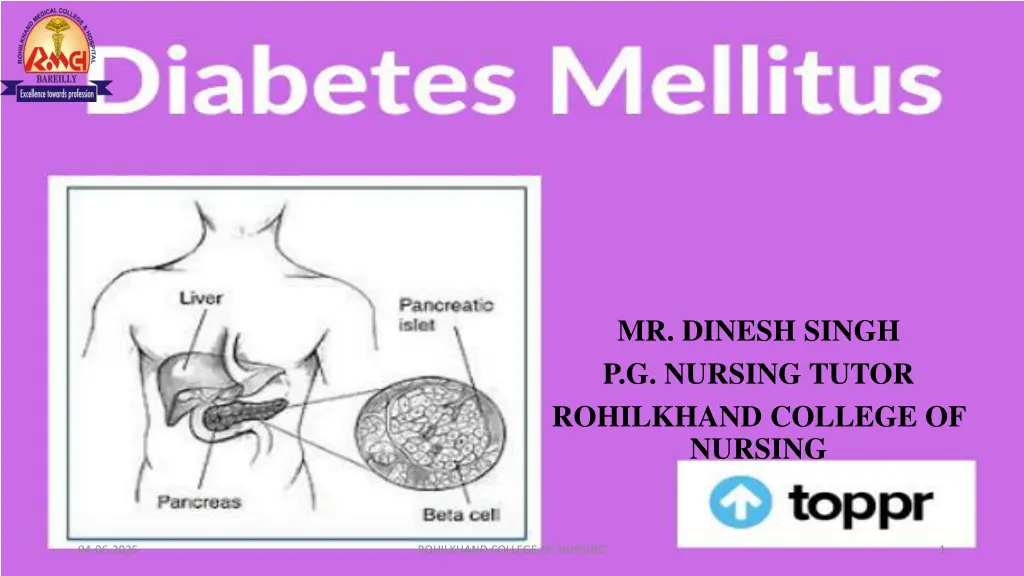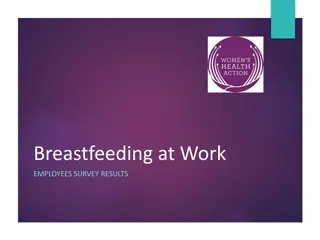
Understanding Diabetes Mellitus: Types, Symptoms, and Management
Learn about Diabetes Mellitus, including its definition, causes, clinical manifestations, diagnostic evaluation, management, prevention, and types like IDDM, NIDDM, and Gestational DM. Explore the role of insulin, the effects of hyperglycemia, and factors contributing to diabetes, such as heredity and obesity. Gain insights into maintaining healthy blood sugar levels and addressing insulin sensitivity for optimal health and well-being.
Download Presentation

Please find below an Image/Link to download the presentation.
The content on the website is provided AS IS for your information and personal use only. It may not be sold, licensed, or shared on other websites without obtaining consent from the author. If you encounter any issues during the download, it is possible that the publisher has removed the file from their server.
You are allowed to download the files provided on this website for personal or commercial use, subject to the condition that they are used lawfully. All files are the property of their respective owners.
The content on the website is provided AS IS for your information and personal use only. It may not be sold, licensed, or shared on other websites without obtaining consent from the author.
E N D
Presentation Transcript
MR. DINESH SINGH P.G. NURSING TUTOR ROHILKHAND COLLEGE OF NURSING 04-06-2025 ROHILKHAND COLLEGE OF NURSING 1
OBJECTIVES Introduction of the Diabetes Mellitus. Define the Diabetes Mellitus. Explain the causes of Diabetes Mellitus. State the clinical manifestations of Diabetes Mellitus. Elaborate the diagnostic evaluation of Diabetes Mellitus. Discuss the management of Diabetes Mellitus. Describe the prevention of Diabetes Mellitus. 04-06-2025 ROHILKHAND COLLEGE OF NURSING 2
DEFINITION It is the condition in which carbohydrate metabolism disturbed due to insufficient secretion of insulin hormones. It is characterized by tried features, e.g., Polyuria, Polyphagia, Polydypsia Glucose level in blood increases. This is known as hyperglycemia. Normal blood sugar level; Fasting: 70-110 mg/dl Postprandial (PP): 80-150 mg/dl 04-06-2025 ROHILKHAND COLLEGE OF NURSING 3
CONTI Insulin Itas a hormone produced by pancreas. It maintains the level of blood glucose by regulating the production and storage of glucose. As well as carbohydrates, fat and protein metabolism also affected in this case. 04-06-2025 ROHILKHAND COLLEGE OF NURSING 4
TYPES OF DIABETES MELLITUS 1. IDDM (Insulin Dependent Diabetes Mellitus) It this condition, patient is unable to produce endogenous insulin due to destruction of pancreatic beta cells by genetic immunologic and environmental factors. About 5-10% cases have diabetes type I of Total DM It has sudden onset, usually before the age of 30 years (Mostly in young age) Insulin therapy is necessary. 04-06-2025 ROHILKHAND COLLEGE OF NURSING 5
CONTI 2. NIDDM (Non-insulin Dependent Diabetes Mellitus) It results from a decreased sensitivity to insulin (insulin resistance) or from a decreased amount of insulin production. About 90-95% of patient have type-2 DM. Type-2 diabetes is first treated with diet and exercise and then with oral hypoglycaemic agents as needed. It occurs mostly after 40 years of age. About 80% cases due to obesity There is no need of exogenous insulin 04-06-2025 ROHILKHAND COLLEGE OF NURSING 6
CONTI 3. Gestational DM Gestational diabetes is characterized by any degree of glucose intolerances with onset during pregnancy (Second or Third trimester). 04-06-2025 ROHILKHAND COLLEGE OF NURSING 7
ETIOLOGY Heredity Obesity, mostly due to imbalance insulin level because supply of insulin is less and requirement is more in obesity. Old age (pancreatic functions become slow) Other systemic disease. Like Heart disease, MI stroke. Renal disease Virus (Coxsackie B, Strepto) Africans and Asians are more susceptible. 04-06-2025 ROHILKHAND COLLEGE OF NURSING 8
PATHOPHYSIOLOGY Destruction or inflammation of beta cells of Langerhans of pancreas Decrease secretion of insulin Insulin requirement is not sufficient for total body Obstruction or disturbances in carbohydrates metabolism Increase blood sugar level Decreases Glycogen level and decreases energy, patient feels fatigue Weight loss due to improper carbohydrates metabolism and also increases appetite. 04-06-2025 ROHILKHAND COLLEGE OF NURSING 9
CLINICAL MANIFESTATION In early stage (No symptoms) 3P s Symptoms Polyuria Polydypsia Polyphagia 04-06-2025 ROHILKHAND COLLEGE OF NURSING 10
CONTI Later Symptoms are: Cramps in legs, feet and fingers Slow healing of cuts Drowsiness Blurred vision Skin infections Itching (Pruritis) Tingling and numbness in hands or feet Weight loss Vaginal infection Skin becomes dry Hypotension Fatigue 04-06-2025 ROHILKHAND COLLEGE OF NURSING 11
DIAGNOSTIC EVALUATION History collection Physical examination Blood glucose level test: Fasting plasma glucose level- 126 mg/dl or more Random or PP- 180 mg/dl or more Detection of complication 04-06-2025 ROHILKHAND COLLEGE OF NURSING 12
MANAGEMENT 1. Pharmacological Management Insulin injection should be given according to blood sugar level. It should given before meal (half an hours) in three times in a day. Hypoglycaemic drugs, e.g., Pioglitazone Hydrochloride, Metformin (Biguanides), Glipizide (second generation sulfonylureas). 04-06-2025 ROHILKHAND COLLEGE OF NURSING 13
NURSING MANAGEMENT Assessment Get base-line information, e.g. Polyurea, polydipsia, polyphagia Take family history of DM Assess knowledge level of patient s and family Perform physical assessment Assess anxiety level of patient 04-06-2025 ROHILKHAND COLLEGE OF NURSING 14
DIETARY MANAGEMENT Sufficient quantity of diet is very necessary which satisfy to appetite. About 1/2 energy should be get from carbohydrates, and 1/3 energy get from fat and 15-20% from protein. Meal should be taken at regular time. If meal will be late, it may cause hypoglycemic attack. Total calories- 2200/8800 KJ should be taken. 04-06-2025 ROHILKHAND COLLEGE OF NURSING 15
COMPLICATIONS Kidney Disease: Albuminuria, Oedema in legs, High Blood pressure, Uremia Neuropathy: Pain in legs, Sexual impotency, Retrograde ejaculation, Sweating, Muscles damage Infection: Tonsillitis, Pneumonia, Appendicitis, Pyelitis (inflammation of pelvis of the kidney). 04-06-2025 ROHILKHAND COLLEGE OF NURSING 16
SUMMARY 04-06-2025 ROHILKHAND COLLEGE OF NURSING 17
REFERENCES 04-06-2025 ROHILKHAND COLLEGE OF NURSING 18
04-06-2025 ROHILKHAND COLLEGE OF NURSING 19







